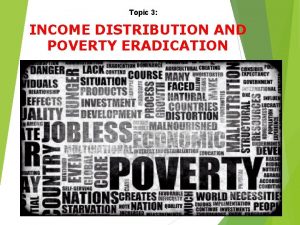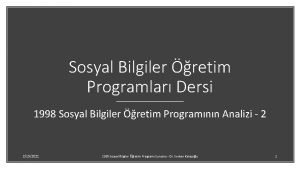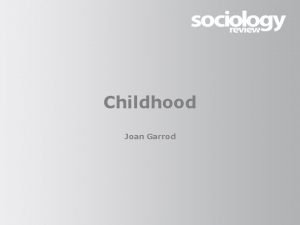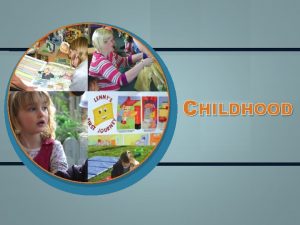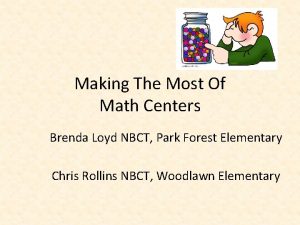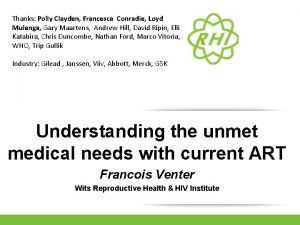Children and Poverty Mc Loyd 1998 Childhood poverty









- Slides: 9

Children and Poverty Mc. Loyd (1998) • Childhood poverty is a major problem in the US – Over 22% of children in the US live in poverty as compared to 9% in Canada (1992) – Individuals that are poor and live in a poor community are even more disadvantaged because of less jobs, good-quality education, and social supports. • Risk of poverty is higher in single-mother families – Low wages for women, poor economic conditions, low education of single mothers, lack of child support from fathers.

Effects of Poverty on Children's Cognitive Dev. • Many studies show significant effects of poverty on children’s cognitive functioning (IQ scores) and verbal skills – Remain significant after controlling for maternal education, family structure, ethnicity (Duncan, 1994) – Poverty was a better predictor of IQ than maternal education – Poverty at age 3 predicted IQ at age 5, even when IQ at 3 was controlled for • Relation between income and IQ is nonlinear – Positive effects of income on cognition are largest for those near poverty line (compared to higher-class) • Persistent poverty worse than transient poverty

Mediating Variables • Physical health of child – Physical health problems combined with less resources to remediate these complications hinder cognitive dev. – Prematurity (low birth weight) is associated with many neurological and cognitive problems – Prematurity is more common in poorer individuals because of inadequate nutrition and prenatal care – Higher rates of prenatal exposure to substances among poorer infants, which affects cognitive development – Lead poisoning associated with cognitive deficits, and poor children have higher levels of lead in blood due to older housing and exposure to environmental pollution • Home-Based cognitive stimulation – Poverty and low maternal education are associated with less cognitive stimulation in home – Cognitive stimulation in home is linked to child’s IQ

Effects of Poverty on Academic Achievement • Poor children do worse on many measures of academic achievement as compared to non poor – Achievement tests, grade retention, course failures, placement in special education, high school graduation • Persistent poverty worse than transient poverty • Early poverty (during first 5 years) is worst • Neighbourhoods with more affluent families are associated with better academic achievement – Seasonal effects: neighbourhoods have more positive effects during summer months, but these gains are stronger for those from higher-SES neighbourhoods

Mediating Variables • Parental and home factors that affect achievement – Verbal interactions with mothers, parental expectations, positive relationships with parents, discipline – Emotional support and cognitive stimulation in home – Literacy resources in home, discussing school, parental education – In home resources have greatest effects during summer, which are strongest for high SES children • Teacher and school characteristics – Teacher attitudes, school values, classroom climate – Teachers perceive poorer children less positively: less positive attention, fewer learning opportunities, and less reinforcement – Schools that stratify classes have more achievement gaps

Mediating Variables • Physical health status – Poverty affects school achievement partly because of poorer physical health • Protective Processes – Parenting: strict, directive, defined rules and supervision, warmth – Preschool education programs increase school readiness, but effects may wash out with time

Effects of Poverty on Socioemotional Functioning • Higher rates of emotional and behavioral problems among poor children and adolescents – Externalizing problems (aggression, acting out) more common than internalizing (anxiety, depression) • Persistent poverty worse than transient poverty Mediators: Parental dysphoria, harsh inconsistent punishment – Parent’s emotional responses & child-rearing behaviors • Discrete and chronic stressors: more negative life events among poor children – Parental conflict, violence, poor housing, homelessness Protective factors: positive parenting and adult role models, preschool intervention programs

Poverty, Civic Communities, and Supervised Sports • Supervised sports helps develop social skills, self esteem, and reduce school drop out • In 1994, 1/3 of children almost never participated in supervised sports • >60% of children from very poor homes almost never participated in supervised sports vs 27% of those from well-off homes Two factors: poverty and community variables • Civic Communities: safe to play during the day, adults to look up to and supervise • 72% of children in civic communities participate in supervised sport vs 58% in non civic comm. • Universal and targeted programs for at-risk

Coping with Child Hunger • Poverty is related to poor health, nutrition, development, and school readiness • Hunger is a universal symbol of deprivation • Coping strategies: food bank and relatives • Single mothers more likely to use food bank (less social support) • 34% of mothers say they skip meals, parents 7 times more likely to go hungry than children • At-Risk: single parent families, off-reserve Aboriginal, low income • >50% of mothers have a chronic health condition • Many still had education, indicating that education alone in not enough
 Ellen loyd
Ellen loyd La stella nascosta di samuel loyd soluzione
La stella nascosta di samuel loyd soluzione Distinguish between absolute and relative poverty
Distinguish between absolute and relative poverty Early childhood and middle childhood
Early childhood and middle childhood Cutler friedmann and mccoy (1998)
Cutler friedmann and mccoy (1998) The provision and use of work equipment regulations
The provision and use of work equipment regulations 1998 sosyal bilgiler öğretim programı
1998 sosyal bilgiler öğretim programı Sabah water resources enactment 1998
Sabah water resources enactment 1998 Nation vs state
Nation vs state Bruscia 1998
Bruscia 1998


